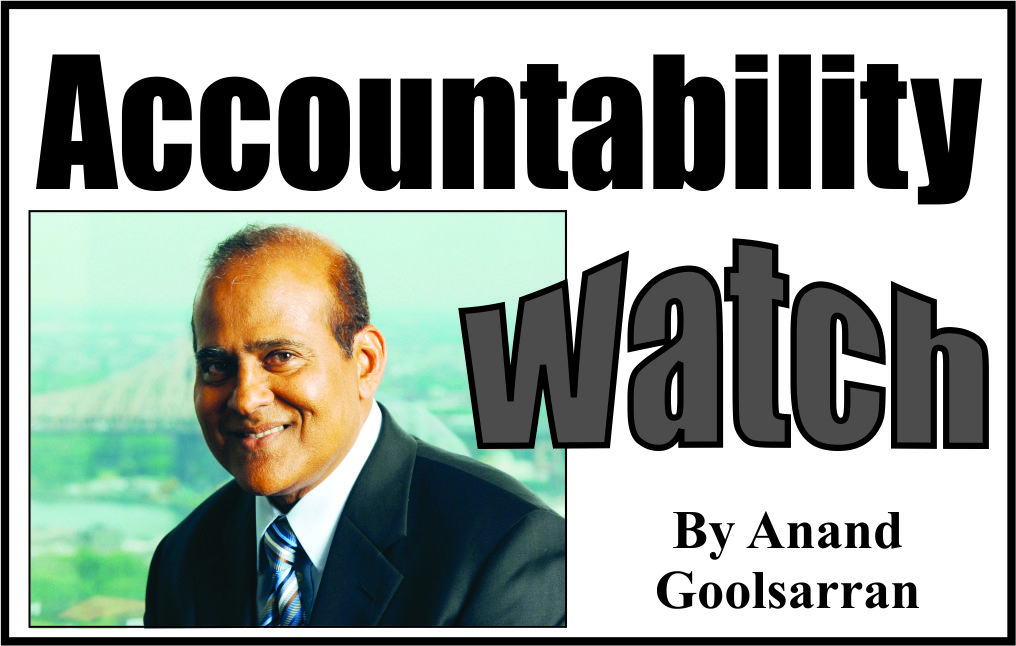On 10 December 2020, the Auditor General presented to the Speaker of the National Assembly his report on the audit of the public accounts for the fiscal year ended 31 December 2019. The report was laid in the Assembly last Wednesday. Its finalization was delayed due to the restrictions relating to the COVID-19 pandemic. The deadline for submission was 30 September 2020.
In today’s article, we highlight the key findings of the 2019 Auditor General’s report.
Statements and accounts submitted to the Auditor General
The statements and accounts required to be submitted for audit examination and certification are the accounts of Ministries, Department and Departments comprising the appropriation accounts, and receipt and disbursements statements; and the consolidated financial statements of the public accounts. The latter set of statements consists of:
(a) Statement of revenues and expenditures in the form of the End-of-Year Budget Outcome and Reconciliation Report;
(b) Financial reports of extra-budgetary funds;
(c) Schedule of the issuance and extinguishments of all loans;
(d) Schedule of Government guarantees;
(e) Statement of contingent liabilities;
(f) Financial reports of Deposit Funds;
(g) Schedule of the public debt;
(h) Financial reports of any other accounts approved by the Minister of Finance; and
(i) Such other financial information that the Minister deems necessary to present fairly the financial trans actions and financial position of the State.
Statements (a) to (g) were submitted to the Auditor General, except that relating to extra-budgetary funds for which no such funds have been created since the passing of the Fiscal Management and Accountability (FMA) Act of 2003. As regards (h) and (i), the following statements were submitted:
(a) Receipts and Payments of the Consolidated Fund;
(b) Expenditure of the Consolidated Fund compared with the Estimates of Expenditure;
(c) Expenditure in respect of those Services which by Law are directly charged upon the Consolidated Fund, otherwise known as Statutory Expenditure;
(d) Receipts and Payments of the Contingencies Fund;
(e) Assets and Liabilities of the Government;
(f) Appropriation Accounts of Budget Agencies; and
(g) Receipts and Disbursements of Budget Agencies.
Certification of the statements and accounts
There are three main types of audit opinions that are normally issued by external auditors – unqualified; qualified; and disclaimer of opinion. An unqualified opinion is issued where there are no reservations based on uncertainty or disagreements of a material nature that affect the fair presentation of the financial statements. Where, in the judgment of the auditor, such reservation affects the fair presentation, a qualified audit opinion is issued. A disclaimer of opinion relates to reservations/disagreements of such a fundamental nature that the auditor states that he/she is unable to express an opinion on the related financial statements.
Of the thirteen sets of financial statements submitted for audit examination, the Auditor General’s opinion relates to only eight statements. This is despite the fact that in the opening paragraph of his opinion, the Auditor General referred to his audit of ‘the Public Accounts of Guyana, which comprise the Consolidated Financial Statements, the Accounts of all Budget Agencies, the Appropriation Accounts and the Statements of Receipts and Disbursements of Ministries, Departments and Regions’. The statements for which no audit opinion was issued are:
(a) Receipts and Payments of the Consolidated Fund;
(b) Expenditure of the Consolidated Fund as compared with the Estimates of Expenditure;
(c) Statutory Expenditure;
(d) Appropriation accounts of budget agencies; and
(e) Receipts and disbursements by budget agencies.
As indicated in our article of 14 September 2020, the International Standards on Auditing (ISAs) and the International Standards of Supreme Audit Institutions (ISSAIs) require the Auditor General to express an opinion on all the financial statements presented to him. Without such an opinion, legislators and the public at large would be at a loss to ascertain his overall conclusions on the fair presentation of the statements and compliance with applicable laws, regulations and circular instructions. We had raised this matter in relation to the audit of the 2018 public accounts and had suggested that an explanation was needed for the departure from this practice for the last four years.
Of the eight sets of statements for which opinions were issued, only three were unqualified – Schedule of Issuance and Extinguishments of Loans; Schedule of Government Guarantees; and Statement of Contingent Liabilities. Qualified opinions were issued on two sets of statements – End-of-Year Budget Outcome and Reconciliation Report; and Schedule of the Public Debt. In respect of the remaining three sets of statements, the Auditor General disclaimed his opinion on them. These are Financial Reports of the Deposit Fund; Receipts and Payments of the Contingencies Fund; and the Statement of Assets and Liabilities of the Government.
The rigorous nature of government accountability
Government accountability is far more rigorous and comprehensive than that which prevails in the private sector due mainly to the fact that the expenditure of public services is financed from taxpayers’ funds. The national budget is very detailed on government programmes and activities, and there are specific rules and procedures on how the funds are to be expended, as outlined in the FMA Act, related Regulations and circular instructions. The Estimates are prepared on a programme, sub-programme and activity basis, and there are specific line items of expenditure which cannot be varied without approval at the appropriate level.
In the private sector, accountability ends at the Annual General Meeting (AGM) of shareholders where the audited accounts are presented. Due to shareholder apathy, very few questions are raised at the AGM in relation to the accounts. Government accountability, however, does not end with the tabling of the Auditor General’s report to the Legislature. That report has to be examined by the Public Accounts Committee (PAC) and includes hearings at which heads of budget agencies and other officials are required to provide explanations in relation to the findings and recommendations of the Auditor General. At the conclusion of its hearings and deliberations, the PAC then presents its report to the Assembly with its own findings and recommendations. The report is referred to the Government, and a Treasury Memorandum is tabled in the National Assembly setting out what actions the Government proposes to take or has taken in relation to the PAC’s recommendations.
The entire accountability ought to be completed within 12 months of the close of the fiscal year to enable the Legislature to review the results of the previous fiscal year’s budgetary allocations as a basis for its consideration of the Estimates for the following year. The key questions that legislators tend to ask are: To what extent the budgetary allocations for the previous year have been expended in accordance with the wishes and intent of Parliament? Were the expenditures incurred with due regard to economy, efficiency and effectiveness? Were the funds managed with due regard for the avoidance of waste and extravagance? Was there evidence of mismanagement, corruption and fraud in the use of public resources? Were the actual outcomes and impacts commensurate with those envisaged in the budget documents? Which programmes and activities are in need of review for their continued relevance?
Regrettably, the PAC, which is tasked with the responsibility of reviewing the public accounts, is yet to complete its examination of and reporting for the years 2015, 2016, 2017, 2018. The last PAC report was in respect of 2012-2014. When account is taken of the recently tabled 2019 Auditor General’s report, the PAC’s work would have been five years in arrears. The implications of this undue delay is that by the time the PAC gets its act together, some heads of budget agencies and other officials will not be in place to provide the necessary answerability. That apart, citizens are very unlikely to be interested in what happened five years ago. In the circumstances, the PAC’s examination becomes an academic exercise. This is why the PAC has to make every endeavour to bring its work up to date.
Need to improve the quality of government financial reporting
While we may be somewhat justified in our feeling of elation that for the past 28 years there has been annual financial reporting audit of the public accounts, compared with what prevailed during the pre-1992 years, we need to reflect on the quality such reporting as reflected in the Auditor General’s certification of the public accounts. In the private sector, the slightest qualification of the accounts of a company can result in a shake-up of management. Despite some of the shortcomings identified in the Auditor General’s report, especially as they relate to the actual certification of the public accounts , it is unacceptable for the public accounts to continue to be qualified year in year out without evidence of any dedicated effort to bring about improvements in public accountability.
The Government continues to use the cash basis of accounting to record, process and report on financial transactions. While some may argue that such an accounting and financial reporting framework is simple and easy to operate, and that it assists parliamentarians to monitor and control expenditure; it is very much incomplete and can result in various forms of abuse. These include: the acceleration of expenditure in the last quarter of the year to exhaust budgetary allocations; circumvention and/or manipulation of the public procurement procedures; postponement of activities so as to avoid overrunning budgetary allocations; failure to return to the Treasury all unspent balances at the end of the year; and drawing of cheques at the end of the year for the payment of goods, services and the execution of works for which value is yet to be received.
As far back as 2015 and earlier, the Government had decided to move away from the use of the cash basis of accounting to an accrual-based one consistent with international accounting and financial reporting standards. In this regard, it had agreed to a progressive phase-in of the International Public Sector Accounting Standards (IPSAS). However, except for some amount of training that took place, there has been little or no progress.
To be continued –






